Imagine entering a dance studio and seeing a group of male and female dancers hard at work creating a complicated pattern of concentric circles, moving gracefully to the strains of the Waltz of the Flowers from Tchaikovsky’s The Nutcracker. Or perhaps the dancers are tapping their toes, stretching their arms and smiling to the beats of Big Band classics. Concentration and joy fill the studio, yet for many of the participants this is their first experience in a dance class.
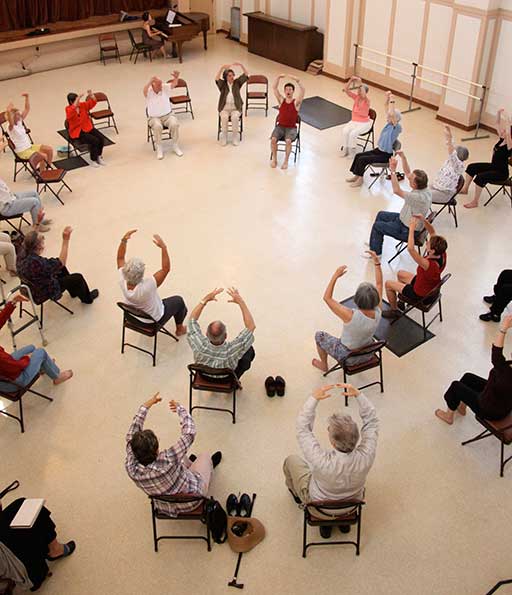 US-based Dance for Parkinson's classes. Photo: Walter Swarthout.
US-based Dance for Parkinson's classes. Photo: Walter Swarthout.It is with great excitement Dance for Parkinson’s Australia is celebrating the first anniversary of multiple, ongoing classes throughout Australia as well as continued interest in program growth. The timing for sharing our celebration is ideal as September brings increased focus on Parkinson’s disease with Parkinson’s Awareness week as well as fundraising initiatives by Parkinson’s groups across the country. In Australia 1 in 350 people have Parkinson’s and 30 people are diagnosed daily (Parkinson’s Australia Report). Parkinson’s affects people in different ways and no two people have exactly the same symptoms or experience.
For people with Parkinson's disease, high quality dance classes led by trained professional teaching artists are becoming internationally acknowledged and valued as both a creative activity and an evidence-based therapeutic intervention. From my own dancer’s perspective, these classes are a beautiful and satisfying way to authentically share my own experience and passion for the art form in way that also connects to community.
Spearheaded by the extensive work of the US-based Dance for PD® program, resources and access to opportunities for dance classes have increased worldwide. Over the past two-and-a-half-years, I have been fortunate to work with inspiring people and communities to launch Dance for Parkinson’s classes throughout Australia, and it is thrilling to see the interest and growth in the program.
Why dance?
For people with Parkinson's disease, rigorous dance classes led by trained professional teaching artists are becoming internationally acknowledged as an important, beneficial and welcome addition to the portfolio of recognied, movement-based therapeutic interventions that are supported by published research.
By approaching movement as dance students, not as patients, people with Parkinson’s can focus on PD-specific concerns like mobility, balance, rhythm and flexibility in an enjoyable, social and communal environment. Dance classes create an environment emphasising expression, creativity, engagement and positive relationship building. Dance is a unique vehicle, naturally combining multiple approaches to foster exercise, confidence building and an improved quality of life.
 US–based class with David Leventhal teaching. Photo: Walter Swarthout.
US–based class with David Leventhal teaching. Photo: Walter Swarthout.Parkinson’s disease (PD) is a neurodegenerative disease resulting from the depletion of dopamine, a chemical in the brain’s basal ganglia. Among other things, the decrease of dopamine can affect movement, resulting in difficulties related to performing everyday movement related activities such as walking. Overall participation and quality of life can be affected, as difficulty moving is generally progressive, often eventually leading to reduced interaction and increased isolation. Research suggests that dance may be an appropriate and effective strategy for improving both physical and mental symptoms of Parkinson’s disease. Beyond the benefits of exercise, dance offers social and emotional interactions which may increase the quality of life, access to movement, and participation for the members of the PD community (Westheimer 2008; Houston 2012).
Dance for PD®
The Dance for PD® program started as a single collaborative program between the Mark Morris Dance Group (MMDG) and the Brooklyn Parkinson Group (BPG) in New York, offering dance classes free of charge for people with Parkinson's in 2001. Since 2001, Dance for PD® has pioneered an arts-based approach that is being adopted in more than 100 communities around the world.
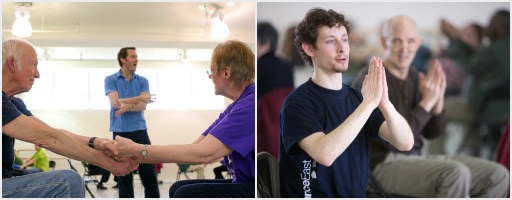 Left image: John Heginbotham leads members of the Brooklyn Parkinson Group in classes at the Mark Morris Dance Center. Photo: Amber Star Merkens. Right image: David Leventhal teaches a Dance for PD class for members of the Brooklyn Parkinson Group at the Mark Morris Dance Center. Photo: Rosalie O'Connor.
Left image: John Heginbotham leads members of the Brooklyn Parkinson Group in classes at the Mark Morris Dance Center. Photo: Amber Star Merkens. Right image: David Leventhal teaches a Dance for PD class for members of the Brooklyn Parkinson Group at the Mark Morris Dance Center. Photo: Rosalie O'Connor.In a Dance for PD class, everyone—people newly diagnosed with PD, others with walkers and wheel chairs, family members, friends—participates. The program strives to highlight what can be accomplished by the participants and to bring dance to people who might not otherwise have the opportunity to take part in these types of creative activities.
Dance for Parkinson’s in Australia
Dance for Parkinson’s classes in Australia started through initial grassroots community building through sharing information and demonstration classes with Parkinson’s support groups and dance teachers. I presented an initial Dance for PD® interactive workshop at the National Parkinson’s Conference in Brisbane in 2012, which provided key exposure and connections for developing programs.
 Teacher Training Workshop with David Leventhal and Erica Rose Jeffrey (Australia 2013). Photo: Fiona Coe
Teacher Training Workshop with David Leventhal and Erica Rose Jeffrey (Australia 2013). Photo: Fiona CoeWorking with Dance for PD® founding teacher and Program Director David Leventhal, the first Australian teacher training workshops were offered in May of 2013 in Sydney and at Queensland Ballet in Brisbane. From that initial training, ongoing programs have developed in Brisbane (with Queensland Ballet), Canberra (at the Belconnen Arts Centre), Sydney and Melbourne as well as Dance for Parkinson’s based classes in Shoalhaven and the Sunshine Coast. Each class is varied and draws on different artistic and community elements.
For Australian class locations and times, visit the Dance for Parkinson's Australia website.
Queensland
In October 2013, Queensland Ballet commenced a pilot program of weekly dance classes for people affected by Parkinson’s, becoming the first dance company in Australia to introduce Dance for PD classes. Dance teachers from the local community, along with dancers from the company, lead participants in 75 minute classes inspired by the company’s repertoire. Queensland Ballet’s program offers Dance for Parkinson's participants and carers a wider insight into the world of ballet by incorporating choreography and music from its repertoire into the classes, and through other opportunities to engage with the company.
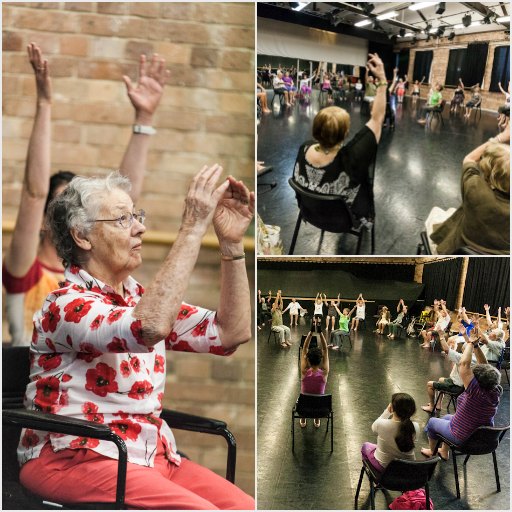 Queensland Ballet's Dance for Parkinson's Pilot Program. Photo: Christian Tiger
Queensland Ballet's Dance for Parkinson's Pilot Program. Photo: Christian TigerThe pilot was accompanied by a research project with QUT’s Creative Industries (Dance) and Health (Movement Neuroscience) faculties and The University of Queensland’s Health and Behavioural Sciences (Physiotherapy) faculty to analyse the social and physical benefits of the program. The pilot concluded in July 2014, and the findings of the research will be released later this year. Recognising the popularity and benefits of the program, Queensland Ballet is continuing to offer ongoing classes.
Australian Capital Territory
Classes in the ACT have developed from a partnership between Parkinson’s ACT and the Belconnen Arts Centre.
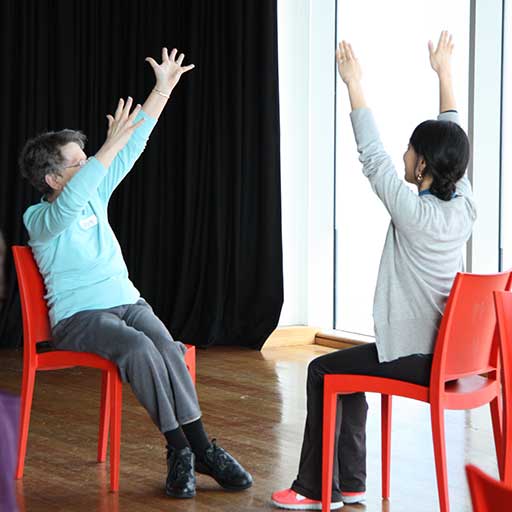 Dance for people with Parkinson's in the ACT.
Dance for people with Parkinson's in the ACT.Led by experienced dance teacher and Community Cultural Inclusion Officer Philip Piggin, classes commenced in July of 2013 with funding from the ACT Government's Inclusive Participation Funding Program (IPFP). In addition to weekly classes, participants have been engaged in other art centre activities and experiences. The program has been successful in receiving further funding through the IMB Foundation to sustain programs and is expanding to start classes at the Tuggeranong Arts Centre thanks to the support of the Regional Arts Fund and the Tuggeranong Arts Centre. Philip Piggin is also the recipient of the prestigious Churchill Fellowship and will travel to the USA and the UK to further develop his skills and experience in teaching dance to people with Parkinson’s.
New South Wales
Sydney-based classes launched officially with a demonstration class at the Parkinson’s Unity Walk in 2013. Building on initial outreach work by dancer Fiona Coe to share information with the Parkinson’s community, ongoing classes launched in Rozelle in October 2013 through the work of teachers Kate Duncan, Zara Duffy and local community members. The Sydney classes have developed to encompass a rich variety of styles, drawing on the experiences of dance teachers Catherine Goss and Christine Denny.
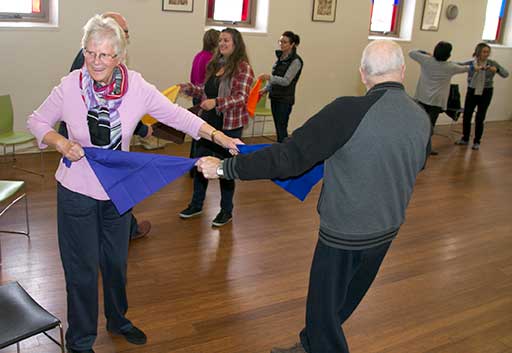 Dance for Parkinson's 2014 classes in Rozelle, NSW. Photo: Kate Duncan.
Dance for Parkinson's 2014 classes in Rozelle, NSW. Photo: Kate Duncan.Classes have continued to grow and in mid 2014 expanded to include a new pilot program in Alexandria at the Village Performing Arts Centre. Through support from the Leichhardt Council, Lundbeck and Parkinson’s NSW, these classes are building community support across sectors. Dance for Parkinson’s based classes are also offered in the Shoalhaven area through the work of Parkinson’s Nurse and advocate Marilia Pereira who was awarded the 2014 Australia Day Citizen of the Year for her work with Parkinson’s.
Victoria
Dance for Parkinson’s Classes in Victoria commenced in February 2014 and are hosted by Elancé Adult Ballet Studio and led by dancer and teacher Paris Wages. We are excited to continue to build the community and connections with Parkinson’s Victoria through presenting at the Parkinson’s Victoria Living Well Seminar and leading a Dance for PD Teacher Training workshop in mid September.
Next steps
While I am very proud of the current programs in Australia, I recognise that this is just the beginning and that there is much greater potential to share the benefits and joy of dance within the Parkinson’s community. It is wonderful to see how the classes have helped to contribute to the connections of arts and health programs in Australia as well as the growth of everyone involved including myself, local dance teachers, participants and communities.
The benefits extend beyond the classes themselves, as seen in Queensland Ballet participant Friday Wright’s experience. Friday was diagnosed with Parkinson’s in March 2012 at the age of 36, and when she first started the Dance for Parkinson’s program, she had lost enthusiasm for many things.
'I was constantly fatigued, and the reduction of activity was impacting on my body weight. I struggled with movement, was suffering deep depression and loneliness and was having trouble adjusting to the loss of independence'.
Joining the program has not only improved Friday’s fitness and movement, but also her attitude and movement.
'Dance for Parkinson’s hasn’t just improved my health and quality of life—it’s given me a place where I feel I can be completely me'.
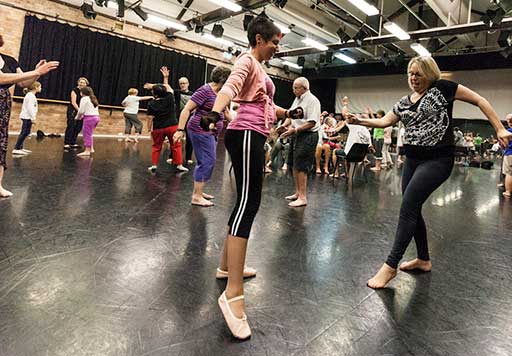 Queensland Ballet's Dance for Parkinson's program participant Friday Wright. Photo: Christian Tiger
Queensland Ballet's Dance for Parkinson's program participant Friday Wright. Photo: Christian Tiger At the end of each class we often pass a pulse of energy as kind of reverence, honoring everyone’s presence. This simple act, used in Dance for Parkinson’s classes worldwide, often brings moist eyes and true sense of connection and caring. Each class grows in its social connections with participants gathering for tea afterwards and it has been wonderful to see the relationships develop and to hear responses to the class. One participant told me that she looks forward to dance all week, while another participant shared how the dance class has served as a ‘gateway’ to trying new activities and experiences, even attending more dance performances.
As confidence levels and creativity within our classes continue to expand, I am reminded of the positive power of dance in our communities and look forward to the strengthening of current programs and development of more connections throughout Australia.
References
- Earhart G. 2009. ‘Dance as Therapy for individuals with Parkinson Disease’. European Journal of Physical Rehabilitation Medicine. June 45(2): 231-238.
- Hackney ME and GM Earhart. 2009. ‘Effects of dance on movement control in Parkinson's disease: a comparison of Argentine tango and American ballroom’. Journal of Rehabilitation Medicine. May 41(6):475-81.
- Heiberger, L., Kristeva, R. et al. 2011.‘Impact of a weekly dance class on the functional mobility and on the quality of life of individuals with Parkinson’s disease’. Frontiers in Aging Neuroscience. Vol. 3 (14).
- Houston, Sara and Ashley McGill. 2012. ‘A mixed-methods study into ballet for people living with Parkinson’s’. Arts & Health: An International Journal for Research, Policy and Practice.
- Goodwin VA, Richards SH, Taylor RS, Taylor AH, Campbell JL. 2008. ‘The effectiveness of exercise interventions for people with Parkinson's disease: a systematic review and meta-analysis’. Movement Disorders. 23(5): 631–40.
- Westbrook BK, McKibben H. 1989. ‘Dance/movement therapy with groups of outpatients with Parkinson's disease’. America Journal of Dance Therapy. 11(1): 27–38.
- Westheimer, O. 2008. ‘Why Dance for Parkinson’s Disease’. Topics in Geriatric Rehabilitation. (2)24:127-140.

